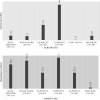Feasibility study for estimating optimal substrate parameters for sustainable green roof in Sri Lanka
- PMID: 36570522
- PMCID: PMC9768404
- DOI: 10.1007/s10668-022-02837-y
Feasibility study for estimating optimal substrate parameters for sustainable green roof in Sri Lanka
Abstract
In twenty-first century buildings, green roof systems are envisioned as great solution for improving Environmental sustainability in urban ecosystems and it helps to mitigate various health hazards for humans due to climatic pollution. This study determines the feasibility of using five domestic organic wastes, including sawdust, wood bark, biochar, coir, and compost, as sustainable substrates for green roofs as compared to classical Sri Lankan base medium (fertiliser + potting mix) in terms of physicochemical and biological parameters associated with growing mediums. Comprehensive methodologies were devised to determine the thermal conductivity and electric conductivity of growing mediums. According to preliminary experimental results, the most suitable composition for green roof substrates comprised 60% organic waste and 40% base medium. Sawdust growing medium exhibited the highest moisture content and minimum density magnitudes. Biochar substrate was the best performing medium with the highest drought resistance and vegetation growth. The wood bark substrate had the highest thermal resistance. Growing mediums based on compost, sawdust, and coir produced the best results in terms of nitrate, phosphate, pH, and electric conductivity (EC) existence. This study provided a standard set of comprehensive comparison methodologies utilising physicochemical and biological properties required for substrate characterization. The findings of this research work have strong potential in the future to be used in selecting the most suitable lightweight growing medium for a green roof based on stakeholder requirements.
Keywords: Green roof; Organic wastes; Sustainable substrate; Urban ecosystems.
© The Author(s) 2022.
Conflict of interest statement
Conflict of interestsThe authors declare that they have no known competing financial interests or personal relationships that could have appeared to influence the work reported in this paper. The authors declare the following financial interests/personal relationships which may be considered as potential competing interests.
Figures











References
-
- Abu-Hamdeh NH, Reeder RC. Soil thermal conductivity effects of density, moisture, salt concentration, and organic matter. Soil Science Society of America Journal. 2000;64(4):1285–1290. doi: 10.2136/sssaj2000.6441285x. - DOI
-
- Al-Shammary AAG, Kouzani AZ, Kaynak A, Khoo SY, Norton M, Gates W. Soil bulk density estimation methods: A review. Pedosphere. 2018;28(4):581–596. doi: 10.1016/S1002-0160(18)60034-7. - DOI
-
- Altland JE. The Pour-Through Procedure for Monitoring Container Substrate Chemical Properties: A Review. Horticulturae. 2021;7(12):536. doi: 10.3390/horticulturae7120536. - DOI
-
- Ampim PA, Sloan JJ, Cabrera RI, Harp DA, Jaber FH. Green roof growing substrates: Types, ingredients, composition and properties. Journal of Environmental Horticulture. 2010;28(4):244–252. doi: 10.24266/0738-2898-28.4.244. - DOI
LinkOut - more resources
Full Text Sources
